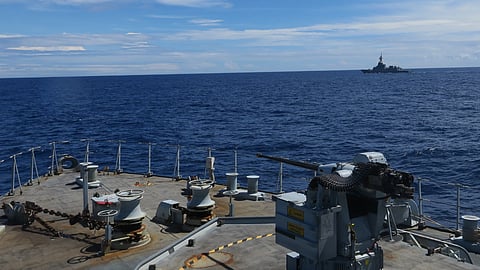OPINION | Australia's freedom-of-navigation activities raise more questions than answers
A freedom of navigation activity that the Australian and British navies jointly conducted near the Spratly Islands last month was notable. It was the first they’d done together, following a joint Australia and New Zealand transit of the Taiwan Strait in September.
However, the subdued nature of the Australian government’s confirmation of the activity and a missed opportunity to sail through the Taiwan Strait with a British vessel raise more questions than they provide answers.
On June 24, Britain’s Ministry of Defence posted on social media a picture of HMAS Sydney, one of Australia’s three destroyers, and HMS Spey, a small, lightly armed patrol ship and one of two such British vessels currently forward deployed in the Indo-Pacific region.
This was captioned, "HMS Spey and HMAS Sydney have just conducted freedom of navigation activity around the Spratly Islands in the South China Sea, in accordance with UNCLOS," the United Nations Convention on the Law of the Sea.
This revelation prompted questions from the Australian media to the Department of Defence.
Australia does not officially conduct US-style freedom of navigation operations and rarely confirms the presence of its ships near the Spratly Islands, an archipelago in the South China Sea where China has occupied and fortified a number of artificial islands, illegitimately claiming sovereignty over the entire area.
Several Southeast Asian countries and Taiwan assert rival sovereignty claims and also occupy a number of features.
Media questions failed to elicit a statement from Australia’s defence department, but it subsequently released several captioned pictures of the joint sailing, confirming that a "freedom of navigation activity" had taken place around the Spratly Islands, without specifying precise details. A release of captioned images is about as low-key as an official confirmation can be.
Sydney and Spey operating together in the Spratly Islands was a positive and concerted signal in support of shared regional security interests and a sign of the deepening defence partnership between Australia and Britain.
The more frequently US allies and partners deploy their armed forces and operate together in the South China Sea, the harder it is for China to assert that it’s only the US that opposes Beijing’s excessive claims and irresponsible activities to disrupt lawful navigation and overflight.
While China’s navy apparently behaved professionally during the combined Australian-British movement around the Spratly Islands, Australian surveillance flights are still singled out for harassment near the Paracel Islands, which China also occupies.
But nagging questions remain: why was Australia reluctant to confirm the joint Spratlys activity after Britain had already publicised it? Moreover, why was an obvious opportunity to sail jointly through the Taiwan Strait missed?
Before linking up in the South China Sea, Sydney and Spey were both in Northeast Asian waters enforcing UN maritime sanctions. In between these joint activities, Spey conducted a solo transit through the Taiwan Strait.
Sydney could easily have accompanied Spey in a joint transit, sending a more potent diplomatic signal to China, as well as providing protection for an under-gunned British ship in contested waters.
Why then did Sydney use a different, possibly more circuitous route to its subsequent rendezvous point with Spey near the Spratly Islands? Operational factors may have been one consideration, but diplomatic considerations are more likely to account for any decision in Canberra to keep the Australian warship out of the Taiwan Strait.
Australia’s Department of Foreign Affairs and Trade is well known to be averse to Australia undertaking military activities that could upset diplomatic and economic relations with China. Such caution is significantly amplified in the lead-up to a prime ministerial visit to Beijing.
The internal pressure to postpone an Australian Taiwan Strait transit until after Prime Minister Anthony Albanese’s visit to China would be considerable. Canberra could be eyeing another opportunity later this year—for example, when Sydney returns from Japan with a British carrier strike group that’s in the Indo-Pacific.
Canberra’s overriding current foreign policy focus is to deliver a trouble-free second visit by the prime minister to China, next week.
The fact that Australia, Britain, the US and other partners will kick off the large-scale Talisman Sabre military exercises in northern Australia while Albanese and his business-heavy entourage are in China for a full week, is a pointed contrast that suits Beijing’s narrative: it appears to reveal where Canberra’s real priorities lie.
Australia’s decision to send a warship close to the Spratly Islands in company with the Royal Navy last month is commendable. Yet in the wider scheme of things, it appears clear that Australia’s military activities in China’s environs are ultimately subordinate to higher policy priorities in the bilateral relationship, such as trade.
Article reprinted with permission from the Australian Strategic Policy Institute's analysis and commentary site The Strategist.


